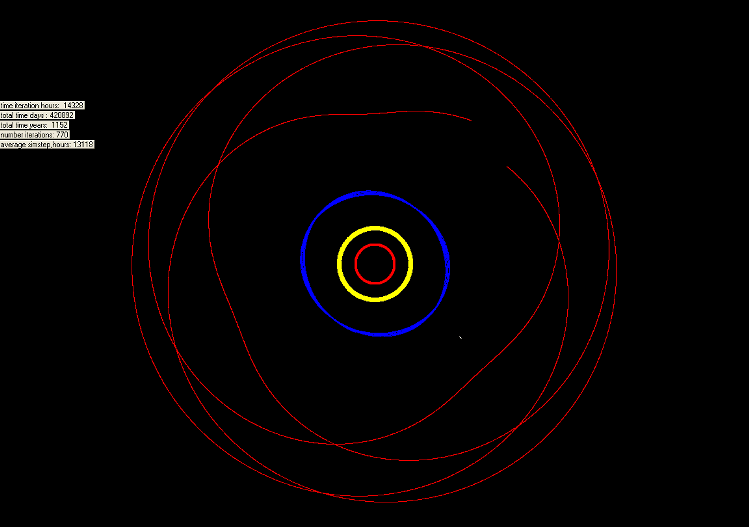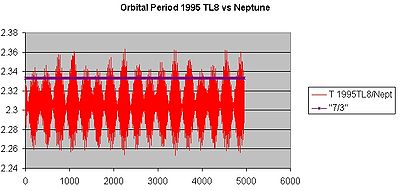_1995_tl8.gif)
(48639) 1995 TL8
Encyclopedia
is a detached (extended–scattered disc
) trans-Neptunian object
possessing a relatively large satellite.
The assumed diameter of 352 km is derived from an albedo
guess of 0.09, being typical for trans-Neptunian objects.
project, it was the first of the bodies presently classified as a scattered-disc object
(SDO) to be discovered, preceding the SDO prototype by almost a year.
 A companion was discovered by Denise C. Stephens and Keith S. Noll from observations with the Hubble Space Telescope
A companion was discovered by Denise C. Stephens and Keith S. Noll from observations with the Hubble Space Telescope
taken on November 9, 2002, and announced on October 5, 2005. The satellite, designated S/2002 (48639) 1, is relatively large, having a likely mass of about 10% of the primary. Its orbit has not been determined, but it was at a separation of only about 420 km to the primary at the time of discovery, with a possible orbital period of about half a day and an estimated diameter of 161 km.
(DES) since its orbit appears to be beyond significant gravitational interactions
with Neptune
's current orbit. Though if Neptune migrated outward, there would have been a period when Neptune had a higher eccentricity.
Simulations by Emel’yanenko and Kiseleva in 2007 show that appears to have less than a 1% chance of being in a 3:7 resonance
with Neptune, but it does execute circulations near this resonance.
It has been observed 48 times and has an orbit quality code of 4 (0 being best; 9 being worst).

 To see a proper 3:7 resonance with Neptune, see: .
To see a proper 3:7 resonance with Neptune, see: .
Scattered disc
The scattered disc is a distant region of the Solar System that is sparsely populated by icy minor planets, a subset of the broader family of trans-Neptunian objects. The scattered-disc objects have orbital eccentricities ranging as high as 0.8, inclinations as high as 40°, and perihelia greater...
) trans-Neptunian object
Trans-Neptunian object
A trans-Neptunian object is any minor planet in the Solar System that orbits the Sun at a greater distance on average than Neptune.The first trans-Neptunian object to be discovered was Pluto in 1930...
possessing a relatively large satellite.
The assumed diameter of 352 km is derived from an albedo
Albedo
Albedo , or reflection coefficient, is the diffuse reflectivity or reflecting power of a surface. It is defined as the ratio of reflected radiation from the surface to incident radiation upon it...
guess of 0.09, being typical for trans-Neptunian objects.
Discovery
Discovered in 1995 by Arianna E. Gleason as part of the SpacewatchSpacewatch
Spacewatch is a project at the University of Arizona led by Robert S. McMillan that specializes in the study of minor planets, including various types of asteroids and comets...
project, it was the first of the bodies presently classified as a scattered-disc object
Scattered disc
The scattered disc is a distant region of the Solar System that is sparsely populated by icy minor planets, a subset of the broader family of trans-Neptunian objects. The scattered-disc objects have orbital eccentricities ranging as high as 0.8, inclinations as high as 40°, and perihelia greater...
(SDO) to be discovered, preceding the SDO prototype by almost a year.
Satellite

Hubble Space Telescope
The Hubble Space Telescope is a space telescope that was carried into orbit by a Space Shuttle in 1990 and remains in operation. A 2.4 meter aperture telescope in low Earth orbit, Hubble's four main instruments observe in the near ultraviolet, visible, and near infrared...
taken on November 9, 2002, and announced on October 5, 2005. The satellite, designated S/2002 (48639) 1, is relatively large, having a likely mass of about 10% of the primary. Its orbit has not been determined, but it was at a separation of only about 420 km to the primary at the time of discovery, with a possible orbital period of about half a day and an estimated diameter of 161 km.
Scattered–extended object
is classified as scattered–extended by the Deep Ecliptic SurveyDeep Ecliptic Survey
The Deep Ecliptic Survey is a project to find Kuiper belt objects , using the facilities of the National Optical Astronomy Observatory .The principal investigator is Bob Millis....
(DES) since its orbit appears to be beyond significant gravitational interactions
Perturbation (astronomy)
Perturbation is a term used in astronomy in connection with descriptions of the complex motion of a massive body which is subject to appreciable gravitational effects from more than one other massive body....
with Neptune
Neptune
Neptune is the eighth and farthest planet from the Sun in the Solar System. Named for the Roman god of the sea, it is the fourth-largest planet by diameter and the third largest by mass. Neptune is 17 times the mass of Earth and is slightly more massive than its near-twin Uranus, which is 15 times...
's current orbit. Though if Neptune migrated outward, there would have been a period when Neptune had a higher eccentricity.
Simulations by Emel’yanenko and Kiseleva in 2007 show that appears to have less than a 1% chance of being in a 3:7 resonance
Resonant trans-Neptunian object
In astronomy, a resonant trans-Neptunian object is a trans-Neptunian object in mean motion orbital resonance with Neptune. The orbital periods of the resonant objects are in a simple integer relations with the period of Neptune e.g. 1:2, 2:3 etc...
with Neptune, but it does execute circulations near this resonance.
It has been observed 48 times and has an orbit quality code of 4 (0 being best; 9 being worst).



